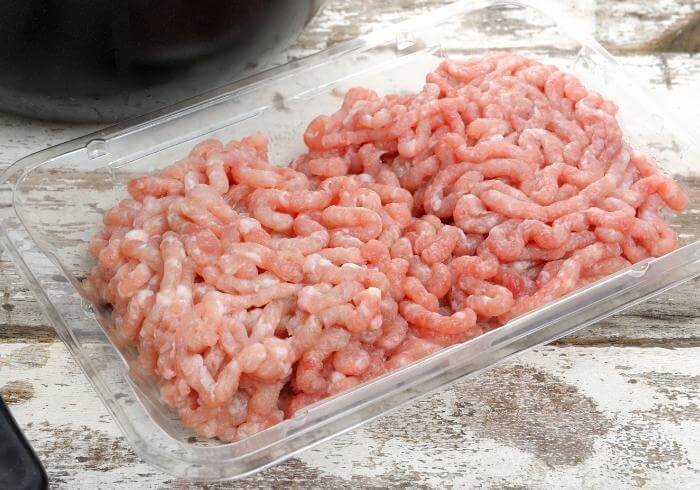Even the best cooks can make a mistake occasionally and end up with bad ground pork. If you’re not sure whether or not your ground pork has gone bad, there are signs you can look for to help you decide.
The easiest way to know if ground pork is bad is by its smell and expiration date. If those signs are okay, you’ll need to check if the texture is slimy, the color is off, or the taste is bad. If anything indicates spoilage, don’t eat it and throw it out.

Here are some specific signs to help you understand when your ground pork has gone bad.
Signs That Tell Ground Pork Is Bad
Date Has Expired
Check the best-by date before you open your package of ground pork. If the date has passed, do yourself a favor and don’t open it, just toss it.
Use the date as a best-case scenario because it doesn’t always mean that it will be good up until that date. The temperature at the store, your cart, your car, your refrigerator, and the time it takes to get home all affect spoilage times.
If you’re using a value pack or bulk chub of ground pork, you should use it up as quickly as possible from the fridge or freeze it immediately.
Ground pork can be stored in the freezer for up to six months. After that point, it will start to deteriorate in quality. If you’re not sure how long your pork has been in the fridge or freezer, throw it out to save your dinner!
The Color Is Off
How does it look? Fresh ground pork should be pink and not dull or gray.
Gray ground pork doesn’t always mean that it has spoiled. Often you’ll find the lower half a bit gray because it has been sitting for a while.
Similar to ground beef, this could indicate that oxygen has been exhausted from that area. And just like blood, it needs oxygen to keep its pink color which no longer exists.
But it’s always important to be cautious because old blood and juices will cause your meat to spoil much quicker.
The Smell Is Off
Once you open the package, the first thing that you will notice is that it smells bad. People often describe that their bad ground pork smells sour, while others say it smells like rotting meat.
Several factors influence the smell, so you may find that it smells like eggs or sulfur. I thought I’d add here that if your ground pork happens to have the skin added to it, it can give off a urine smell. This doesn’t mean it’s bad, but it can be very off-putting.
Did you buy your ground pork in a package that contains a soaker pad? These pads are notorious for smelling bad as they collect blood and juices. They are designed to help keep your meat fresh, but the rotting process happens in these, and they can smell bad.
I always advise not purchasing meat if you can see the soaker pad looks old. And when you bring ground pork home, remove the pad immediately, and cook or store your pork for later.
Your nose is a good indicator that will alert you that your ground pork has spoiled, so listen to it. If you’re not quite sure, ask someone else for their opinion or simply toss it out and save yourself a potential trip to the hospital.
The Texture Is Slimy
If you’ve decided that the above signs are okay, check the texture of the pork. Does it feel slimy?
Slimy pork is an indication of bacteria growth. Think about how small bacteria are and how many of them it would take to make meat feel slimy. While some of these bacteria are harmless when cooked, others can cause food poisoning.
If your ground pork is slimy, proceed with caution and make sure that it is cooked to the proper temperature.
The USDA recommends 160°F (71.1°C) as the minimum internal temperature for ground meats, excluding poultry. But because ground pork isn’t like a roast, it will be a bit challenging to measure unless it’s made into a loaf.
I like to mash my ground pork while it’s cooking on medium heat until it all turns gray and firms up, and then turn up the heat to brown it with a little extra oil. It’s not exact, but I don’t have a good way to measure the temperature of loose bits of ground pork.
It Has An Unpleasant Taste
Now that you’ve cooked your ground pork, you realize that it tastes funny. If you’ve been using the same recipe for a while, you’ll definitely be able to taste the difference.
It’s not just you. Once pork spoils, it will have an unpleasant taste that is hard to describe. The main thing you might notice is that it tastes sour or acidic. But I’ve also noticed that it usually smells off as well.
Stop eating it and throw it out.
Bad Ground Pork FAQs
What Does Ground Pork Look Like?
Fresh ground pork should look pink and moist but not wet.
Does Ground Pork Smell?
Yes, ground pork has a light smell, but if it smells sour, fishy, or like rotting meat, it’s probably bad, and you should throw it out.
What Does Bad Ground Pork Look Like?
Bad ground pork will likely have some discoloration, such as gray, green, or brown patches. They could be indications of rotten ground pork, freezer burn, or simply expired. It’s best to throw it out.
Can Eating Ground Pork That Has Gone Bad Make You Sick?
Yes, eating bad ground pork can cause food poisoning. Symptoms can include nausea, vomiting, diarrhea, and abdominal pain. If you experience any symptoms, see a doctor immediately.











